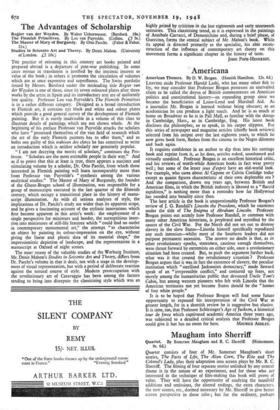The Advantages of Scholarship
Studies in Seicento Art and Theory. By Denis Mahon. (University of London. £2 10s.)
THE practice of reissuing in this country art books printed and prepared abroad is a departure of post-war publishing. In some cases reissue in translation is justified by the intrinsic interest or value of the book ; in others it promotes the circulation of volumes which are at once expensive and superfluous. The Swiss portfolio issued by Messrs. Batsford under the misleading title Rogier van der Weyden is one of these, since its seven coloured plates after three works by the artist in Spain and its introductory text are of uniformly low quality. Professor Leo van Puyvelde's The Flemish Primitives is in a rather different category. Designed as a broad introduction to Flemish art, it contains 151 black and white and colour plates which provide a good general survey of the development of Flemish painting. But it is surely inadvisable in a volume of this class to illustrate details of paintings which are not shown whole. At the beginning of his preface Professor van Puyvelde attacks the scholars who have " possessed themselves of the vast field of research which the art of the early Flemish painters has to offer them," and as befits one guilty of this trahison des clercs he has contrived to write an introduction which is neither scholarly nor genuinely popular.
" I am not decrying the merits of scholars," continues the Pro- fessor. " Scholars are the most estimable people in their way." And as if to prove that this at least is true, there appears a succinct and stimulating volume by a scholar, Dr. Otto Paecht, from which those interested in Flemish painting will learn incomparably more than from Professor van Puyvelde's " synthesis among the various analytical studies." The Master of Mary of Burgundy, the founder of the Ghent-Bruges school of illumination, was responsible for a group of manuscripts executed in the last quarter of the fifteenth century, which occupy a transitional place in the history of manu- script illumination. As with all serious analyses of style, the implications of Dr. Paecht's study are wider than its apparent scope, and he gives a fascinating account of the stylistic innovations which first become apparent in this artist's work: the employment of a single perspective for miniature and border, the surreptitious inser- tion into miniatures of still-life features which " could find no outlet in contemporary monumental art," the attempt " to characterise an object by painting its colour-impression on the eye, without giving the linear and plastic data of its material shape," the impressionistic depiction of landscape, and the representation in a manuscript at Oxford of night scenes.
The most recent of the valuable studies of the Warburg Institute, Mr. Denis Mahon's Studies in Seicento Art and Theory, differs from Dr. Paecht's volume in that it deals, not with a stage in the develop- ment of visual representation, but with a period of deliberate reaction against the natural course of style. Modern preoccupation with the revolutionary art of Caravaggio has been among the factors tending to bring into disrepute the classicising style which was so
highly prized by criticism in the late eighteenth and early nineteenth centuries. This classicising trend, as it is expressed in the paintings of Annibale Carracci, of Domenichino and, during a brief phase, of Guercino, forms the central subject of Mr. Mahon's book. While its appeal is directed primarily to the specialist, his able recon- struction of the influence of contemporary art theory on this movement forms a significant chapter in the history of taste.
JOHN POPE-HF-NNESSY.


































 Previous page
Previous page